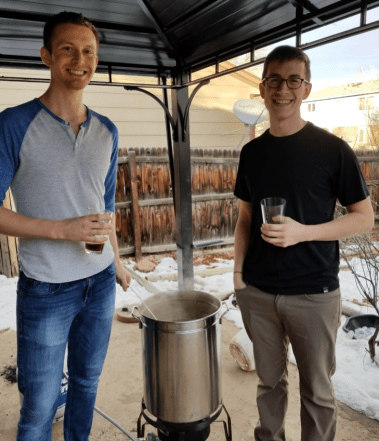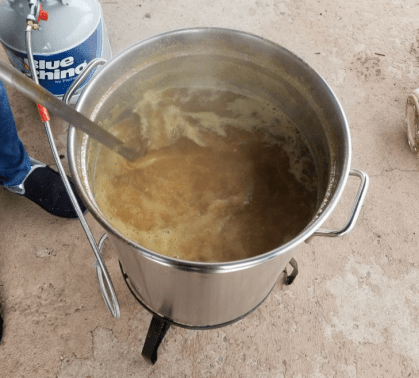The great physicist Richard Feynman once said, “All life is fermentation.” He was referring to the unique chemistry that keeps everything alive and gives us energy. For example, our muscle cells have learned to ferment, giving us energy during an intense workout. However, bacteria and yeast have evolved to be much better at fermentation than the human body, and impressively learned to convert sugar to alcohol. Fortunately, graduate student Doug Peters is harnessing the power of microbes to brew a tasty beverage, at least when he is not in the Garcea lab studying polyomavirus replication.
Doug first started brewing beer during his college days, but didn’t have the resources and space to continue until he moved to Boulder to begin his PhD. He reunited with his friend since pre-school, Sean Hurley, and the two became roommates and brewing partners in their backyard. While Sean now lives in Arvada, the two still brew beer together monthly on Sean’s covered back porch.

Right: Doug Peters; Left: Sean Hurley
The beer brewing process is quite simple. Beer is made from fermented grains, usually preserved and flavored with a flower called hops. Grains, like barley or wheat, are malted (germinated, then dried) and soaked in hot water to release their sugars, creating a liquid called wort. Yes, wort is basically tea. Depending on the recipe, flavorings or fruit can be added before the wort is cooled. In a dark room and a sealed container, yeast then converts the sugar in the wort to ethanol and carbon dioxide, and voilà: brewski.

Early in the process, Doug and Sean mix wort, which is essentially a “grain tea.”
There are two methods for brewing a batch of beer. Extract brewing utilizes syrups to provide sugar for the yeast to turn into alcohol. But Doug and Sean use a slightly more complicated method, known as the “all grain” method. They get their fresh grains at the Home Depot for homebrewers called Boulder Fermentation Supply, and a mill is available to break open the grains. They take their sacks of grain back to the backyard brewery and soak them in hot water to digest the waxy coating surrounding the sugar inside the seeds, preparing a sugary meal for the yeast culture. After adding the hops and letting the wort cool, the yeast is added at just the right temperature.

Doug and Sean prepare a yeast starter (right) in an Erlenmeyer flask to bulk up healthy yeast for the fermentation process. These yeast will convert the wort to the final delicious product on the left.
While they wait for the yeast to do their work, they track the fermentation process with a hydrometer, which measures the ratio of a sample liquid’s density to the density of water. This essential tool provides insight in to how much sugar the yeast converted to alcohol. Doug takes the first reading the day they brew the beer after the wort cools and before adding the yeast. He and Sean will later compare it to the reading after fermentation and periodically during the fermentation week, which helps them adjust their recipe. Fermentation is carefully timed to prevent yeast from dying and releasing “off flavors” into their brew, so Doug and Sean remove the yeast from the beer in a process called “clearing.” After waiting about a month, the beer is crisp, cold, clear, and ready to drink.
Most homebrewers in the Boulder area bottle their beer, which is a meticulous process but beneficial to sell your home brew—with a license, of course. Instead, Sean and Doug keg their beer. “We don’t distribute it—we would rather drink it and share it,” Doug laughs. Doug recently made a keg for his sister’s wedding, and the two frequently share it with friends and family at parties.
“In our partnership, Sean is the motivator and creative one,” Doug explains. “Meanwhile, I take rigorous notes and am much more scientific about it. Brewing is definitely an even mix of the creativity and science.” Doug and Sean use recipes that they collect and exchange with friends, or recipes available online. They have also considered building new recipes. Doug’s meticulous documentation of every step in the process, showing his scientist colors, allows the two brewers to tweak recipes and improve their brew.
Doug and Sean have a distant dream to expand their brewing process, learn and create more recipes, and open their own brewery. Perhaps they will eventually be featured in another “hop-ed” piece like this one.
By Kaitlin McCreery (@k_mccr)
